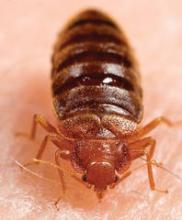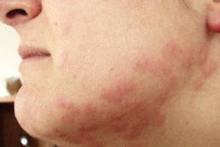WAILEA, HAWAII – There is good news and bad news regarding the highly publicized bedbug resurgence.
The good news is that the much-loathed creatures are not effective vectors for disease transmission. To date, there have been no documented cases of disease transmission to humans via bedbug bites. Studies using animal models have also consistently been negative, Dr. Albert C. Yan said at the Hawaii Dermatology Seminar sponsored by Skin Disease Education Foundation (SDEF).
The bad news is pesticide resistance among bedbugs is a growing problem worldwide. One of the mutations in voltage-sensitive sodium channel alpha subunits associated with reduced bedbug neuronal sensitivity to pesticides has also been noted in permethrin-resistant head lice.
Bedbugs, or Cimex lectularius, are wingless, nocturnal, oval-shaped insects 3-5 mm in size. They are photophobic, hiding in protected places until they come out to feed on blood, typically between 2 and 4 a.m. Feeding takes only a few minutes and is painless because the insects smooth the way by injecting their anticoagulant-rich saliva. Their hosts rarely see them.
Treatment of the skin lesions is straightforward and symptomatic: hydroxyzine or diphenhydramine for the itch, along with a midpotency topical steroid. Guiding the patient to an experienced exterminator is also a big help.
Diagnosing Bites
Bedbug bites appear clinically as juicy pruritic papules that are often excoriated and arrayed in a line. The face and bare arms and shoulders are common locations.
"They tend not to crawl under clothing, so you only see bites on exposed surfaces," explained Dr. Yan, a pediatric dermatologist at Children’s Hospital of Philadelphia.
Only one-third to two-thirds of people will generate a cutaneous reaction when bitten by bedbugs, which is why it is not uncommon for just one of two people sleeping in the same infested bed to develop lesions.
Fecal blood stains on bedding are a clue that bites are due to bedbugs rather than some other insect. When the bedbug becomes loaded with blood it defecates at the feeding site.
Detecting Infestation
It is not hard to locate a significant infestation. Bedbugs give off a distinctive sweet, musty odor. They like to nest along mattress seams, between the mattress and box springs, in cracks in wallpaper near the head of the bed, and in furniture crevices.
When traveling, Dr. Yan routinely strips hotel bed sheets and peers behind headboards and picture frames, he said. If he spots evidence of bedbug activity he simply requests another room. It is unusual for an infestation to take over an entire hotel, he said.
Also, it is a good idea to use the metal luggage stand that is present in most hotel rooms. It lessens the chance that the critters will crawl up into the suitcase at night and hitch a ride in luggage or clothing.
Eradication
"It is very difficult to eliminate an infestation on your own," said Dr. Yan.
Eradication does not come cheap. Licensed exterminators typically charge $250-$1,000 per treated room. Pyrethroids are the treatment of choice, although it is not a terribly effective therapy because of the high resistance rate. Retreatment is necessary after several weeks in order to kill the hatched instars.
With the growing problem of pesticide resistance, new methods of eradicating bedbug infestations are needed. One environmentally friendly, pesticide-free approach involves thermal treatment.
Exterminators place a heater in every room in the house and gradually raise the ambient temperature to around 135 F, holding it there for several hours to kill the bedbugs and their eggs. Plants, pets, medications, candles, oil paintings, and the like must first be removed. While an intriguing approach, Dr. Yan said he has yet to see any studies in the entomologic literature validating its long-term effectiveness.
Do-It-Yourself Bedbug Detection
Before embarking on an expensive extermination program – or to verify its effectiveness – it makes sense to establish that bedbugs are actually present. When the insects are not found on a room search, professional exterminators will place a couple of commercial traps in the room overnight, typically charging $200 or more. But Dr. Yan noted that entomologist Wan-Tien Tsai, Ph.D., of Rutgers University in New Brunswick has come up with a do-it-yourself bedbug detector that patients can easily assemble for about $15.
Her homemade trap involves placing 2.5 pounds of CO2 pellets in a one-third-gallon-size insulated jug or thermos obtainable at a camping supply store. The pour hole is left not quite closed, allowing CO2 to leak out for about 11 hours. Bedbugs are attracted to the gas. The jug is placed in the middle of a plastic cat food dish whose bowl is dusted with talcum powder so that once bedbugs slide in, they cannot crawl out. A paper ramp is taped to the rim of the food dish to assist the bugs in climbing in. The trap is placed overnight near a bedpost.




